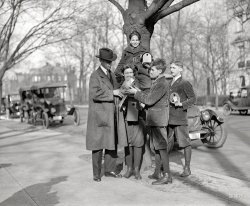
MAY CONTAIN NUTS

Search Shorpy
SHORPY ART

Framed or unframed, desk size to sofa size, printed by us in Arizona and Alabama since 2007. Explore now.
Join and Share
Ad-Free Shorpy
Shorpy is funded by you. Patreon contributors get an ad-free experience.
Learn more.

Recent comments
- Tough Guys
- Lost in Toyland
- And without gloves
- If I were a blindfolded time traveler
- Smoke Consumer Also Cooks
- Oh that stove!
- Possibly still there?
- What?!?
- $100 Reward
- Freeze Frame
- Texas Flyer wanted
- Just a Year Too Soon
- WWII -- Replacing men with women at the railroad crossing.
- Yes, Icing
- You kids drive me nuts!
- NOT An Easy Job
- I wonder
- Just add window boxes
- Icing Platform?
- Indiana Harbor Belt abides
- Freezing haze
- Corrections (for those who care)
- C&NW at Nelson
- Fallen Flags
- A dangerous job made worse
- Water Stop
- Passenger trains have right of way over freights?
- Coal
- Never ceases to amaze me.
- Still chuggin' (in model form)
Member Photos
The Shorpy
Print Emporium
Print Emporium
Search Shorpy
Search results -- 30 results per page
- The Bucking Buick II
- ... View full size. G.G. Bain Collection.
(The Gallery, Cars, Trucks, Buses, G.G. Bain, NYC) ... Posted by Dave - 09/08/2011 - 11:52am -
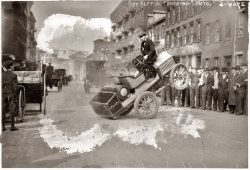
- Mona Lisa: 1920
- ... yet fallen to redevelopment:
(The Gallery, Cars, Trucks, Buses, Chris Helin, San Francisco) ... Posted by Dave - 11/14/2016 - 3:09pm -
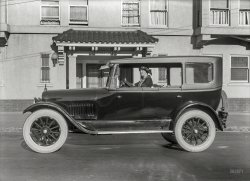
- I'm E.Z.: 1941
- ... Unbelievably dense and heavy! Those short little ore cars, each only 24 feet long to match the spacing of the pockets and loading ... recent pix, held up to 100 tons of iron ore!
The ore cars were shoved by steam locomotives onto the docks and spotted carefully over ... Posted by Dave - 03/10/2020 - 2:35pm -
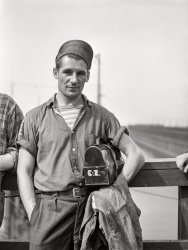
- Florida Souvenirs: 1906
- ... is eager to use all the modern conviniences. If the two cars are any indication, Daytona as a test bed of the new fangled invention ... Posted by Dave - 08/29/2012 - 8:33pm -
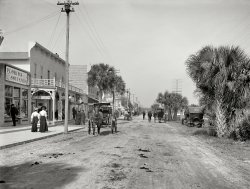
- National Tube Works: 1910
- ... rather new looking Lake Shore and Michigan Southern hopper cars in the company of the Baltimore and Ohio units. I wonder what track ... Posted by Dave - 07/29/2012 - 1:32pm -
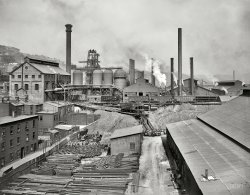
- Theory & Practice: 1917
- ... from burning. It does the same job as the capacitor in old cars with points & condensor ignition. I'm a retired electronics tech but ... Posted by Dave - 04/30/2014 - 10:06am -
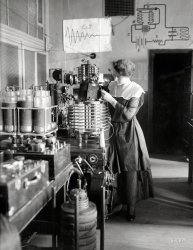
- Safety Patrol: 1959
- ... of fun. We directed traffic in the parking lot (stopping cars so buses could back out) and at the gate (letting traffic in and out). ... Posted by Dave - 05/19/2018 - 4:37pm -
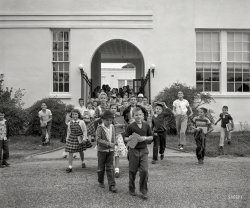
- American Pickers: 1937
- ... in the photo.
(The Gallery, Arthur Rothstein, Cars, Trucks, Buses, Florida, Great Depression) ... Posted by Dave - 02/12/2014 - 1:58pm -
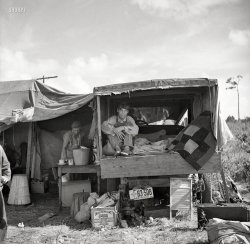
- Meet Miss Vroom: 1920
- ... name, how many kids and all their names.
(The Gallery, Cars, Trucks, Buses, Harris + Ewing) ... Posted by Dave - 04/20/2013 - 9:10pm -
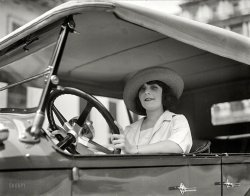
- Co-op Gasoline: 1937
- ... in a different capacity.
(The Gallery, Cars, Trucks, Buses, Gas Stations, Russell Lee) ... Posted by Dave - 02/23/2017 - 5:09pm -
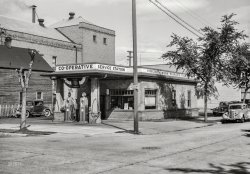
- Oceanside Tennis: 1906
- ... 3 here, plus 1 electric monstrosity.
(The Gallery, Cars, Trucks, Buses, DPC, Sports) ... Posted by Dave - 08/21/2012 - 7:51pm -
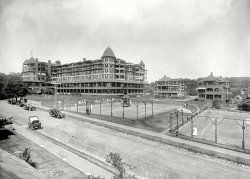
- Four's Company: 1943
- ... Gordon Parks did to document Engine 4.
(The Gallery, Cars, Trucks, Buses, D.C., Fires, Floods etc., Gordon Parks) ... Posted by Dave - 02/19/2019 - 8:46pm -
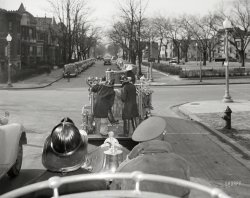
- Second City Service: 1941
- ... would be replaced by the gold crowns.
(The Gallery, Cars, Trucks, Buses, Chicago, Gas Stations, John Vachon) ... Posted by Dave - 09/20/2020 - 4:11pm -
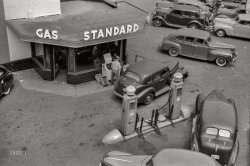
- Park-Vista: 1941
- ... on the street below the apartment.
(The Gallery, Cars, Trucks, Buses, Chicago, Russell Lee) ... Posted by Dave - 09/25/2018 - 11:55am -
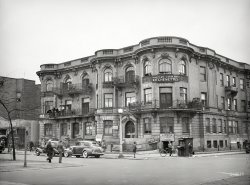
- The Bucking Buick III
- ... the showman, is steering with his FOOT!
(The Gallery, Cars, Trucks, Buses, G.G. Bain, NYC) ... Posted by Dave - 09/08/2011 - 11:51am -
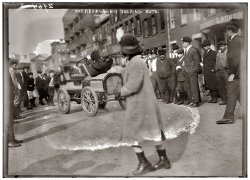
- Modern Mail: 1917
- ...
MOTOR TRUCK CHEAPER
(The Gallery, Cars, Trucks, Buses, D.C., Natl Photo) ... Posted by Dave - 07/10/2019 - 7:48pm -
![Modern Mail: 1917 Washington, D.C., circa 1917. "U.S. Mail trucks -- Parcel Post delivery." National Photo Company Collection glass negative. View full size.
The philatelic angleThe Post Office Department began Parcel Post service on January 1, 1913. A set of 12 stamps was issued in denominations from 1¢ to $1, several of them depicting various vehicles used in the transportation and delivery of PP. For some reason, the 15-center with a truck is labeled "Automobile Service."
[Motor trucks are automobiles! - Dave]
MOTOR TRUCK CHEAPER
(The Gallery, Cars, Trucks, Buses, D.C., Natl Photo)](https://www.shorpy.com/files/images/SHORPY-31351u.thumbnail.jpg)
- Ready for Takeoff: 1912
- ... of more than 200 miles. It differs from the regular cars in that it is driven simultaneously on all four wheels, fore and rear, and ... Posted by Dave - 08/26/2012 - 11:44am -
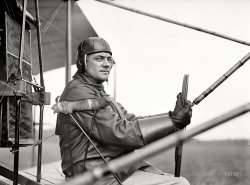
- De Old Museum: 1918
- ... gas extraction and stainless steel.
(The Gallery, Cars, Trucks, Buses, Chris Helin, San Francisco) ... Posted by Dave - 09/01/2017 - 10:05pm -
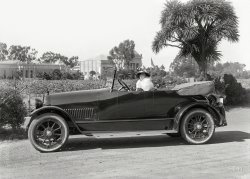
- You Better Watch Out: 1940
- ... headquarters.
(The Gallery, Arthur Rothstein, Cars, Trucks, Buses, Kids) ... Posted by Dave - 12/18/2007 - 11:43pm -
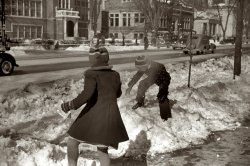
- Easy Payments: 1906
- ... the timbre, the echo of city streets was before motor cars assaulted the auditory canals? Being "in the city" must have been a very ... Posted by Dave - 08/13/2012 - 9:14pm -
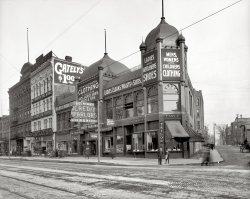
- Young Pete: 1913
- ... were working to make sure the family ate. Computer games, cars and the latest phone fad were still some way off.
Reality check I ... Posted by Dave - 01/08/2009 - 5:24pm -
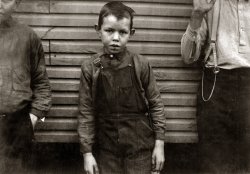
- Beer for Rent: 1943
- ... Interesting parking regulations in that town. I see two cars parked parallel with the curb facing the opposite way of traffic, one ... Posted by Dave - 06/17/2008 - 1:38am -
![Beer for Rent: 1943 March 1943. "Raceland, Louisiana. U.S. Highway 90." View full size. Medium format nitrate negative by John Vachon for the Office of War Information.
Borne'sI know the Borne family...it's amazing what Shorpy turns up.
SignsI own a sign company and would love to have those old signs in my shop!
Raceland I'm from Raceland and would love to have a copy of this photo. I have one of the old bridge that crosses Bayou Lafourche. JBoogawa@yahoo.com I'm also interested in any old photos of Raceland. Contact me.
I want the signs!The signs shown here are awesome! Can I please have them ALL?
WowWhat a difference 66 years makes! I travel the entire stretch of Hwy. 90 between Lafayette and New Orleans almost on a weekly basis for work and still had to study this photo for about 30 minutes trying to pinpoint where this was taken.
Parking During WartimeInteresting parking regulations in that town. I see two cars parked parallel with the curb facing the opposite way of traffic, one parked diagonally nose in, and one parked perpendicular to the curb, tail in. (That last one could have a driver and be pulling into this "main street" to make a turn). But they do at least have one regulation. You can't park near the bridge. If you come to that town, you need to know, that is the one and only rule they seem to have.
Great titlesOne thing I love about this website is the witty headers, like this one's ~ "Beer for Rent"!
Does the same person come up with all of those headers?
[He does! - Dave]
(The Gallery, Eateries & Bars, John Vachon)](https://www.shorpy.com/files/images/8d28223u.thumbnail.jpg)
- More Apple Candy: 1940
- ... the same pump island.
(The Gallery, Arthur Rothstein, Cars, Trucks, Buses, Gas Stations) ... Posted by Dave - 01/25/2018 - 6:14pm -
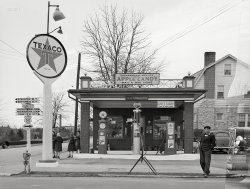
- Rim Shot: 1920
- ... to me: "Vickie Dugan" by the Limeliters!
(The Gallery, Cars, Trucks, Buses, Chris Helin, San Francisco) ... Posted by Dave - 09/14/2017 - 10:36am -
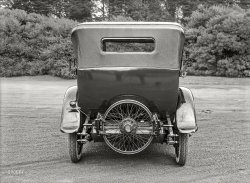
- Glossy Gardner: 1922
- ... crash of 1929, that didn't happen.
(The Gallery, Cars, Trucks, Buses, Chris Helin, San Francisco) ... Posted by Dave - 05/10/2020 - 8:25pm -
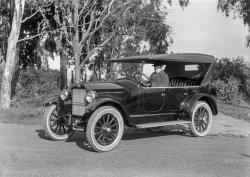
- The Albion: 1905
- ... in 1878.
Watch your step. Is that what trolley cars left behind in those days?
Cinematic Delights A poster on the far ... Posted by Dave - 05/17/2014 - 9:47pm -
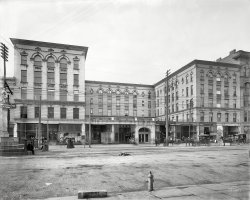
- King of the Road: 1941
- ... after 10-plus years of the Depression.
(The Gallery, Cars, Trucks, Buses, Jack Delano) ... Posted by Dave - 12/06/2018 - 12:12pm -
![King of the Road: 1941 March 1941. "Construction worker from Fort Bragg. He lives in this homemade bunkhouse in Manchester, North Carolina." Medium format acetate negative by Jack Delano for the Farm Security Administration. View full size.
Old StreetcarAs evidenced by the destination sign area and light areas on either side. I would not be surprised if this went back to the horse drawn era.
[This is a metal van or bus body that originally would have been mounted on a truck chassis, similar to the vehicles seen here and here. - Dave]
Camp ConstructionThere is an awesome series of photos in the Library of Congress archives taken by Marion Post Wolcott, as I recall, during the early part of 1941, covering the area around Alexandria, Louisiana, at the time several large Army camps were being built in the vicinity. Many of the photos were of construction workers living in similar accommodations as the one shown here.
Despite the Spartan lodgings, I imagine the workers were more than happy to have a steady job after 10-plus years of the Depression.
(The Gallery, Cars, Trucks, Buses, Jack Delano)](https://www.shorpy.com/files/images/SHORPY-8c04843a.thumbnail.jpg)
- Oakland Rider: 1920
- ... keep that Oakland out of Oakland....
(The Gallery, Cars, Trucks, Buses, Chris Helin, San Francisco) ... Posted by Dave - 12/19/2015 - 11:16am -
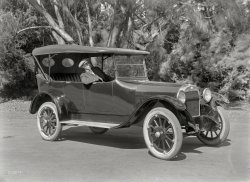
- Twenty-One: 1980
- ... think of taking photos of the streets, businesses, and cars, in Durham, NC, where I live. I mean, how interesting could such photos ... Posted by Dave - 01/02/2021 - 2:00pm -
![Twenty-One: 1980 "21 Club, Buffalo, Wyoming, 1980." 35mm color transparency from the John Margolies Roadside America photographic archive. Happy New Year from Shorpy! View full size.
Coors in 1980 addendaCoors was the beer of the West back then; you couldn't legally buy it east of the Mississippi. Got a couple cases of it out here in Michigan back then and thought WOW, let's party!! It tasted like Golden water. Back to Stroh's.
Time TravelIs it just me, or was 1980 just 10 or 20 years ago; not FORTY years ago.
Lesson LearnedAmen to that. Back in the 70s, my hometown built a nice pedestrian mall, which I photographed extensively. It was unpopular, and was razed in the '90s, and the streets put back in. The director of the historical society said all their photos were monochrome newspaper shots, so they were delighted to get my slides. I kept the scans and gave them the originals.
Doubt this is Buffalo, NYI've lived here for 70 years and do not recognize this. I've also shared on Facebook "Former Buffalo Restaurants" and no one else recognizes. It might be Buffalo, Wyoming.
[Indeed it is. Caption corrected! - Dave]
Buffalo, Wyo.Here's a current photo of the building.
Coors in 1980Coors was kind of a big deal back then. Smokey and the Bandit helped.
Re: Coors in 1980When I first saw this I was wondering about Coors being available in Buffalo, NY in 1980. As I had recalled it wasn't sold in the the eastern US until later in the eighties. Thanks for clearing this up Dave!
The Shorpy lessonSeeing this photo reminds me that I never think of taking photos of the streets, businesses, and cars, in Durham, NC, where I live. I mean, how interesting could such photos be? But Shorpy shows every day that subjects that seem mundane and uninteresting in the here and now are hugely interesting in later years. So, take some pictures, people, and save them.
Tempus FugitMan, I’m getting old when the year 1980 makes it on to Shorpy!
(The Gallery, Kodachromes, Eateries & Bars)](https://www.shorpy.com/files/images/SHORPY-07290a.thumbnail.jpg)
- Birdhouse Boys: 1921
- ...
I like the bark birdhouse myself.
(The Gallery, Cars, Trucks, Buses, D.C., Natl Photo) ... Posted by Dave - 08/21/2014 - 12:33pm -
